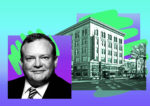 BH Properties launches $1B affordable housing strategy
BH Properties launches $1B affordable housing strategy
Trending
Disparity in Boston housing market reflected in luxury towers
Speculation mounts about whether condo towers are homes or merely investments

The disparity in Boston’s housing market is starkly evident in the juxtaposition of two residential experiences: the luxurious living at the Four Seasons One Dalton and the affordable housing struggles faced by middle-class and low-income residents.
The soaring tower of One Dalton, symbolizing the city’s opulence, offers a curated lifestyle for the super-wealthy, replete with extravagant amenities and services, the Boston Globe reported.
However, for most Bostonians, the dream of owning a multimillion-dollar condo remains far-fetched, with the city’s soaring property prices outpacing the reach of the middle and working classes.
The widening gap between the rich and the rest is exacerbated by the city’s rapid luxury high-rise development, catering predominantly to the affluent, with condos that have $10 million price tags.
With soaring real estate prices and a severe shortage of affordable housing, Boston’s residents are grappling with the stark reality of an increasingly unattainable housing market.
The single-family median sales price in Boston hit a record at $908,000 in June, and the median condo price also hit an all time high in May, at $775,500, according to the Greater Boston Association of Realtors.
Those prices far exceed the income levels of the average Boston household, creating an alarming housing crisis that threatens the city’s social fabric.
While Mayor Michelle Wu’s efforts to increase affordable set-asides and introduce transfer fees on high-end property sales have been commended by some housing advocates, they have drawn fierce opposition from real estate groups concerned about the potential impact on investment and development.
As the debate rages on, Boston’s identity hangs in the balance, with the current trajectory suggesting a city increasingly tailored to the whims of the elite.
Occupancy patterns in the Four Seasons One Dalton and other luxury high-rises in Boston raise questions about the intent behind these multimillion-dollar developments. With a significant portion of units unsold, and a notable absence of residential tax exemptions, speculation mounts about the extent to which these properties are serving as mere investments rather than actual homes.
Concerns about the implications of this phenomenon, such as potential resource diversion and market speculation, have added fuel to the ongoing debate about the city’s housing policies.
As the demand for affordable housing continues to outweigh supply, the city faces the daunting task of bridging the gap between the luxury housing market and the pressing needs of its working-class and marginalized communities.
As Boston navigates this critical juncture, the actions of its government leaders will play a defining role in shaping the city’s future. With a pressing need for comprehensive housing reform that prioritizes the needs of all its residents, the city must grapple with tough questions about equity, access, and the socioeconomic direction it wishes to pursue.
“The next generation is in trouble, unless they have wealthy parents who can help,” economist Barry Bluestone, professor emeritus at Northeastern University, told the outlet.
— Ted Glanzer
Read more
 BH Properties launches $1B affordable housing strategy
BH Properties launches $1B affordable housing strategy
 Affordable housing development stifled amid high rates, costs
Affordable housing development stifled amid high rates, costs




